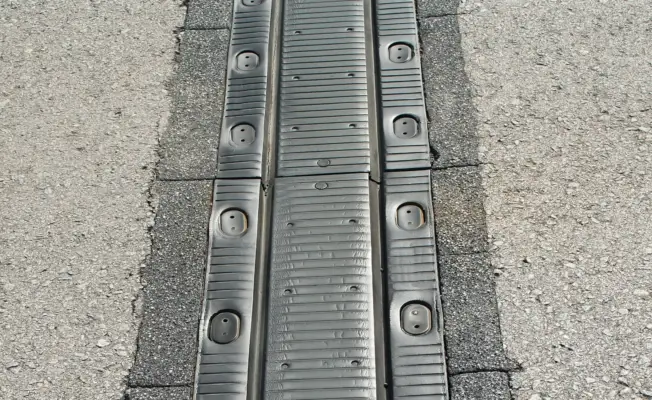Expansion joint sealant systems for bridges

Expansion joint sealant for bridges increases construction reliability
Movement joints, better known as expansion joints in bridges, are designed to keep parts together. Additionally, they safely absorb expansion by temperature changes, contracting of building materials and vibration caused by traffic, ground settlement or seismic activity. The behavior of these bridge expansion joints can be unpredictable if not sealed properly. Therefore, to increase construction reliability, the expansion joint sealant systems for bridges should be chosen carefully. The choice should be based on factors such as material, environment and possible hazards.
Requirements for bridge expansion joint systems
The most common expansion joint sealant systems for bridges fall under three categories. These are MS polymers, polysulfide joint sealants and epoxy polysulfide systems. These three types of sealants all meet the most important requirements for bridge joint sealants:
- Chemical resistance: most bridges are made for vehicle traffic. This means that the bridge joint sealant is likely to come in contact with fuels and their fumes.
- Flexibility: the purpose of expansion joints is to absorb movement caused by various factors. Therefore, the sealant must be flexible and allow for elastic bonding and sealing. There are several types of flexible joint sealant solutions.
- Abrasion resistance: nearly continuous traffic by vehicles of different masses should not affect the expansion joint sealant.
- Load bearing capacity: the expansion joint seal must endure prolonged pressure, for example during a traffic jam.
MS polymer systems as bridge expansion joint sealant
MS polymers, also known as silyl modified polyethers, are a newer addition to expansion joint sealants. The polymer was first developed in Japan in the 1980 ?s and later introduced to the bigger public. MS polymer bridge joint sealant systems offer a sustainable alternative to more conventional systems, as they do not contain solvents, isocyanates or silicone. These sealants are also common in bridge foundations. The advantages of MS polymer bridge joint sealant systems include the following.
MS polymer benefits
- No bubbling: when isocyanates come into contact with water, the reaction produces CO2 molecules. The reaction may cause bubbling and result in sealant failure. Due to the absence of isocyanate groups, this does not happen with MS polymers.
- No shrinkage: the MS polymer sealants are 100% solid meaning that they contain neither solvents nor water. Other water or solvent based systems cure through evaporation, which leads to shrinkage of the expansion joint seal as the density increases and volume decreases.
- Easy and fast application: MS polymer based products require minimum surface preparation, are applicable without a primer and adhere to most surfaces, even damp ones. Contact us and find out more about MS polymers increasing process efficiency.
Polysulfide joint sealant - flexible sealant for bridge expansion joints

Synthetic rubber such as polysulfide is common as a sealant for bridge expansion joint systems due to its versatility. A polysulfide joint sealant is the right choice especially when no plastics are involved or when there is a possibility that the joint needs to be disassembled. Polysulfide is also suitable for bridge expansion joint repair projects, and projects that require an elastic joint sealant.
The solvent used in the sealants may attack plastics resulting in a system failure. When applied to substrates other than plastic, polysulfide expansion joint sealant systems provide excellent adhesion and flexibility allowing for movement associated with stress, vibration and temperature fluctuation.
Polysulfide benefits
- Low temperature flexibility: as the name implies, polysulfide sealants have a high sulphur content. This grants the systems exceptional low temperature flexibility.
- High impermeability: the high sulphur content also contributes to high impermeability which is a desired property as water and contamination should not seep into the joint.
- Adhesive properties: of all the joint sealant options for bridges, polysulfide sealants have the best adhesive properties.
Epoxy polysulfide construction joint sealant
Epoxy expansion joint sealants are known for their extreme toughness, and they are very common as industrial and construction joint sealant solutions. The epoxy resins exist in many types and they are compatible with other ingredients. The type of epoxy joint sealant most commonly used for expansion joints in bridges contain polysulfide. The epoxy polysulfide sealants are more flexible than regular epoxies and tougher than regular polysulfide sealants.
Epoxy polysulfide benefits
- Toughness: epoxy polysulfide sealants for expansion joints in bridges are tougher than the alternatives meaning that they are more resistant to abrasion and have better load bearing capacity.
- Increased chemical resistance: epoxy alone is resistant to a wide range of chemicals, however, the addition of sulphur included in polysulfide broadens the range and even allows for full immersion of the sealant.
Which system is the best for your bridge expansion joints?
Choosing the sealants for expansion joints in bridges may seem like a simple process. However, this is not always the case. As some expansion joints may have specific requirements it is always good to check with a party specialized in joint sealing systems. The suitability of different sealants should be assessed based on the requirements set by the environment, materials, bridge type and expected traffic. Contact us for free assistance in choosing the perfect product and getting in touch with acknowledged expansion joint sealant manufacturers.
Discover more solutions for infrastructure & roads
What solution are you looking for?
We are specialized in the infrastructure and roads. Need the best products or advice? Then please leave your details and we will get in touch.





